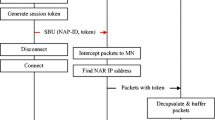Abstract
In the Evolved Packet Core (EPC) network architecture for 4G mobile communication systems, the data delivery is performed based on the GPRS tunneling protocol (GTP) between eNodeB and the gateways. However, the use of GTP tunnels may give some drawbacks, which include large tunneling overhead for packet, non-optimal data paths between Mobile hosts within the same network, and frequent tunnel updates for every handover. In this paper, we propose a new architecture for mobile core network in the emerging 5G mobile systems. The proposed mobile core network architecture is based on the Transparent Interconnection of Lots of Links (TRILL) protocol for data delivery and mobility management, named TRILL-based Packet Core (TPC). In the proposed architecture, each eNodeB will function as a Routing Bridge (RB) of TRILL. The data delivery operations are performed between RBs by using TRILL switching mechanisms, rather than using GTP tunnels. The proposed architecture uses Mobility Management Entity (MME) to manage the mapping information between identifier (IP address of user equipment) and locator (MAC address of RB). For handover of user equipment, the location of users will be updated with MME. By numerical analysis, it is shown that the proposed 5G-TPC architecture can give more performance benefits than the 4G-EPC architecture in terms of data tunneling overhead, total transmission delay and route update delay after handover .





















Similar content being viewed by others
References
Oo, M. Z., et al. (2011). Proxy-assisted routing for efficient data transmission in mobile ad hoc networks. Wireless Network, 17(8), 1821.
FP7 METIS project. (2013). Mobile and wireless communications enablers for the 2020 Information Society. http://www.metis2020.com
Benn, H. (2014). Vision and Key Features for 5th Generation (5G) Cellular—Samsung, Technical Report.
Cisco. (2014). Cisco Visual Networking Index: Global Mobile Data Traffic Forecast Update, 2013–2018, Technical Report.
3GPP TS 23.401. (2014). General Packet Radio Service (GPRS) enhancements for evolved universal terrestrial radio access network (E-UTRAN) Access, Rel-12 Ver. 12.4.0.
Perlman, R., et al. (2011). Routing Bridges (RBridges): Base Protocol Specification. IETF RFC 6325.
IETF Transparent Interconnection of Lots of Links (TRILL). http://datatracker.ietf.org/wg/trill/
Sankaran, C. B. (2012). Data offloading techniques in 3GPP Rel-10 networks: A tutorial. IEEE Communications Magazine, 50(6), 46–53.
IETF Distributed Mobility Management (DMM). http://datatracker.ietf.org/wg/dmm/
Daoud, K., et al. (2008). UFA: Ultra Flat Architecture for high bitrate services in mobile networks. In Conference of PIMRC 2008.
IEEE 802.1aq. (2012). Shortest Path Bridging, Draft 4.6.
Varis, N., et al. (2011). A layer-2 approach for mobility and transport in the mobile backhaul. In Conference of ITST.
Gohar, M., et al. (2014). A distributed mobility control scheme in LISP networks. Wireless Networks, 20(2), 245–259.
Author information
Authors and Affiliations
Corresponding author
Rights and permissions
About this article
Cite this article
Gohar, M., Choi, JG. & Koh, SJ. TRILL-Based Mobile Packet Core Network for 5G Mobile Communication Systems. Wireless Pers Commun 87, 125–144 (2016). https://doi.org/10.1007/s11277-015-3035-5
Published:
Issue Date:
DOI: https://doi.org/10.1007/s11277-015-3035-5




